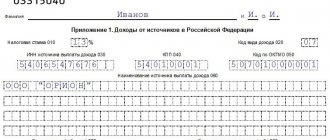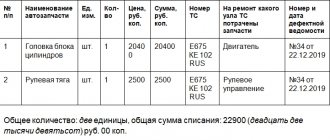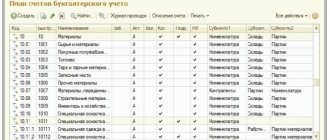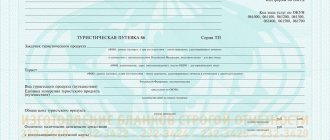Equipment is usually understood as a technical device used independently or installed on a machine, which is necessary to perform its main or additional functions, as well as to combine several machines into a single system (Clause 1, Article 2 of the Technical Regulations, approved by the Decision of the CU Commission dated October 18. 2011 No. 823). In accounting, equipment is generally considered to be property that requires installation before it can perform its essential functions.
We talked about how the receipt of equipment requiring installation by an organization is documented in our consultation, where we provided a sample of filling out the unified form No. OS-14 “Act of acceptance (receipt) of equipment” (approved by Resolution of the State Statistics Committee of January 21, 2003 No. 7 ). In the future, it is assumed that the equipment is transferred for installation, which is usually accompanied by the execution of a unified form No. OS-15 “Act on the acceptance and transfer of equipment for installation” (approved by Resolution of the State Statistics Committee of January 21, 2003 No. 7). However, a situation is possible when capitalized equipment will never be put into operation as part of fixed assets, but for various reasons will be written off. We will tell you how to draw up an equipment decommissioning certificate in our consultation.
Equipment write-off act
Document type: Act
To save a sample of this document to your computer, follow the download link.
Document file size: 15.0 kb
In production, it is necessary to timely update production capacities. This is necessary to increase labor productivity; in addition, the accumulation of outdated and irreparable mechanisms is prohibited by occupational safety and health regulations.
The form for the equipment decommissioning act has a uniform form, however, in the description of the technical characteristics of the mechanisms, a free detailed description is allowed.
The main points of the content of the act on write-off of mechanisms:
- details of approval by the head of the enterprise (signature, date);
- document's name;
- date of drawing up the act;
- composition of the commission that makes the decision;
- number of the order (instruction) for the enterprise on write-off;
- list of mechanisms that cannot be repaired or are outdated (unit of measurement, quantity, service life, time of entry into operation);
- condition of the equipment at the time of write-off;
- final conclusions about the condition of the equipment;
- signature of the chairman and members of the commission.
After the manager approves this act (his signature is certified by a seal), the act is subject to execution.
The act, signed and approved, is the basis for the accounting department to remove this equipment from the balance sheet as fit for use. All three copies of the text of the act are stored in the accounting department for reporting.
Source
Equipment inspection report
The ultimate goal of inspecting the equipment and drawing up a report is to conclude whether the equipment is suitable for further operation and use.
If the commission cannot give such permission, then it must enter into the act the grounds for refusal, including the degree of wear and tear or level of malfunction of the equipment, the possible cost and preliminary time frame for repairs, as well as the measures that need to be taken to eliminate the found defects, flaws and violations .
In some cases, if the equipment can no longer be repaired, based on the act, it can be written off from the organization’s balance sheet.
For a more complete and detailed inspection of the equipment, a whole commission is involved in this procedure. Usually it consists of employees of the organization who work in different departments - as a rule, these are middle managers: chief engineers, technologists, deputy directors, etc.
Sample equipment decommissioning certificate
Equipment write-off act is a document that is drawn up by several persons and confirms the fact that the equipment has been written off.
All organizations are faced with the need to write off old equipment. Computers, office equipment and other property must be disposed of according to a write-off report. Correct write-off requires an expert opinion on the condition of the equipment, which contains an assessment confirming the impossibility of further use. A specially created commission or an invited expert organization draws up a technical inspection report, on the basis of which it is possible to write off fixed assets from the balance sheet and dispose of them.
Property tax has to be paid for equipment that has not been written off but is out of order or obsolete. You can write off fixed assets gradually - through depreciation, but there is a shorter way - drawing up an equipment write-off act. It is recommended to write off material assets that:
- cannot be used because they have become unusable;
- do not exist based on inventory results;
- damaged when repair is impossible or economically unfeasible.
Every year, the head of the organization must issue an order appointing a commission to write off fixed assets. The chairman of such a commission is, as a rule, a deputy director, and the members of the commission are the chief accountant, economists and engineers.
Reasons for decommissioning equipment
In most cases, fixed assets are subject to write-off in the following cases:
— The property has fallen into disrepair.
— It is impossible or economically infeasible to restore the object.
— Equipment does not exist as a single object.
All three circumstances must be present, otherwise the write-off will be illegal.
For example, you cannot write off a computer on the grounds that its performance is not sufficient to run a program. The hardware remains suitable for lower performance programs such as word processing or email. The write-off of the printer will be considered unreasonable if the commission does not include a technical specialist who can confirm that the fixed asset cannot be repaired. It will also not be legal to write off equipment without a decision on its disposal.
If the organization does not have a technical service that can competently confirm the impossibility of restoring equipment, you should contact third-party specialists. The list of activities of the invited organization must include an examination of the technical condition of equipment, a documented level of qualifications of specialists for conducting diagnostics of the relevant fixed assets.
An agreement is concluded with the selected organization with the wording “Diagnostics of equipment to estimate repair costs.” If the certificate of completion of work issued by the invited organization contains a conclusion about the malfunction and impossibility of restoring the equipment, the organization that owns the fixed assets will receive sufficient grounds for write-off.
To make an informed decision about the feasibility of restoring equipment, you should:
— compare the cost of repairs with the price of new equipment;
— assess the consequences taking into account the duration of the repair;
— compare the warranty period of new and repaired equipment.
When making a decision to dispose of equipment, an appropriate act must be drawn up with photographic materials documenting the disassembled (destroyed) object. The photographs must show the brand and serial number of the equipment.
General principles for drawing up a write-off act
Drawing up a write-off act is mandatory in office work. The fact is that each item on the balance sheet has its own value, which is indicated in the relevant accounting documents.
This means, sooner or later, there will be a need to present this item, be it to tax authorities or business buyers. And in case of its absence, documents confirming its write-off are presented.
Hence the importance of its correct preparation. The first thing to note is that, like any audit act, it has the right to be drawn up by a commission.
Its members should include:
— Heads of departments in whose department the value is located.
— Competent engineering staff.
— An accountant may be present.
“And it certainly wouldn’t hurt to have a lawyer involved.”
The act must indicate all identifying information about the value being written off.
This data may include:
— Distinctive technical characteristics.
In addition, it is necessary to clearly formulate the reason for the write-off. This reason will later become the basis. In case of write-off due to breakdown, damage received, etc., it is necessary to obtain a technical examination report before write-off. This act, in turn, will become the basis for write-off.
Structure of the write-off act
The write-off act has a header that includes the name of the document, city and date of preparation. The body of the act indicates all the data that was specified in the previous section.
Certificate of decommissioning of equipment
However, there are some general procedures that all companies are advised to follow.
To begin with, a commission should be created by a separate order from the director of the company. It must include enterprise employees from different departments, including a technical specialist, an accountant and, for example, a lawyer. As part of the execution of its tasks, the commission inspects the equipment, checks its condition, and then draws up an act in which it indicates its characteristics, as well as the reasons why the equipment is subject to decommissioning.
Based on the results of the commission’s activities, the director of the enterprise writes another order and after that all the necessary procedures are carried out to complete the work and dismantle the equipment. The format of the document is not established by law, which means that the act can be written in free form, based on the characteristics of the organization and its needs (except for those cases when the form of the act is approved in the accounting policy of the enterprise).
Equipment write-off act
An act is a document received in the process of drawing it up by several citizens and certifying established events or information. To fill out the equipment decommissioning report, a standardized sample is used, established by legal regulations and mandatory for use. An example of this is shown below.
In addition, it should be taken into account that, in addition to uniform versions of the act, a large number of ministries (departments) use specialized manuals and regulations on the system for drawing up these documents.
Sample equipment decommissioning certificate
The equipment decommissioning act, the form and its example are drawn up by several people based on the results of the work done.
It describes the condition of the object from a technical point of view and the conclusion of a special commission. You must indicate the basis for the write-off. A similar sample act is often used as a supplement to administrative documents of the company’s management. As an example, an order to inspect a capital construction project.
The act of writing off equipment is the main basis for removing an object from accounting, as well as responsibility for it from specific persons. It is often used in cases where repair is impractical or wear has reached a critical point. Additionally, an act of destruction of goods can be drawn up.
Start page of the form:
- write the full name of the document;
- the number is noted;
- the date, month and year of the inspection is recorded;
- since the act is an annex, you need to write down the name of the agreement to which it will relate.
The next point is to list all members of the commission, full names, and positions of inspectors.
Entering the fact of equipment inspection:
- address of the organization where the inspection was carried out;
- types of equipment, inventory number, name, model, etc.
- The next point is to record the results of the inspection, the commission’s conclusions, and recommendations.
The report on identified equipment defects always includes serial numbering of all technical documentation for the equipment.
Certificate of technical condition of equipment
You need to be careful when compiling it, describing in detail all the nuances of the condition of the equipment.
In the future, this may allow you to avoid unfounded claims and, in the event of emergency situations, quickly identify the person at fault.
In order to monitor the technical condition of the equipment, it is necessary to assemble a special commission of competent specialists. It usually consists of full-time employees of the organization: technicians, engineers, installers, electricians, etc. (depending on the type of equipment that is being monitored).
In some cases, third-party experts are also invited, especially if the specifics of the object being inspected require it. The commission is appointed by a separate order of the director of the enterprise.
Design rules
It doesn’t really matter what type of paper the recording will be on. A4 format is best.
The number of copies of the equipment write-off act must strictly correspond to the number of members of the commission. This rule also applies to copies of documents.
After the expert commission puts its signatures, the act is confirmed by a blue seal, which indicates the validity of the document.
The name of the document is entered in a special accounting journal, then placed in a folder with the same forms. The storage period will depend on the norms prescribed by law or the regulatory rules of the organization.
Equipment malfunction report
If necessary, experts from third-party organizations can be involved in investigating the circumstances of the breakdown.
The act does not have a standard unified template, therefore it is drawn up in free form or according to a template developed and approved by the company. It can be written either on a regular A4 sheet or on the organization’s letterhead, both handwritten and printed.
The main thing is that it be certified by the signatures of all members of the special commission. The document must be drawn up in at least two copies, depending on the number of interested parties. Each copy must be certified by original signatures.
The act must contain
- technical specifications and other parameters.
- his passport details,
- information about the name of the equipment,
The more complex the equipment, the more detailed it should be described, right down to recording storage and operating conditions.
Certificate of decommissioning of a circulation pump sample
| Reviews: | 1 | Views: | 8751 |
| Votes: | 1 | Updated: | n/a |
File type Text document
Document type: Act
Remember: Contract-Yurist.Ru - there are a bunch of sample documents here
ACT FOR WRITTEN-OFF OF TECHNICAL EQUIPMENT I approve __________________________ __________________________ "__" _____________ 20___ ACT FOR WRITE-OFF ________________________________ (type of equipment) _________ "__"___________20___ The commission consisting of (positions, names) ________________________ _____________________________________________________________________ _____________________________________________________________________ _____________________________________________________________________ Appointed _________________________________________________________ inspected the technical condition _____________________________ _____________________________________________________________________ As a result of inspection of all components and parts _______________________ _________________, familiarization with the technical passport, the commission established: 1. Basic information Name, brand, plant No. _______________________________ Inventory No. _______________________________ Year of manufacture ________________________________ Date of receipt ________________________________ Time of commissioning ________________________________ Book value ________________________________ Number of overhauls performed _______________________________ Date of last overhaul _______________________________ 2. Technical condition ?+++-+++++++++++++++ +++++++++++++++-+++++++++++++++++++++++++++++++++++- + No.+ Name of main components + Nature of detected defects + ¦++++++++++++++++++++++++++++++++++++++++++ ++++++++++++++++++++++++++++- + + + + + + + + -+++-+++++++ +++++++++++++++++++++-+++++++++++++++++++++++++++++ +++++? 3. Conclusion of the commission _____________________________________________________________________ _____________________________________________________________________ _____________________________________________________________________ Signatures: Chairman of the commission ______________ Members of the commission ______________ ______________ ______________
Download the document “Act for write-off of technical equipment”
Write-off of material assets for other reasons
Write-off of valuables due to the impossibility of their further use can occur:
- Due to the appearance of defects, detection of defects, breakdown, loss of original qualities and properties.
- Due to expiration of service life.
- For other reasons (obsolescence, excessive costs of maintaining valuables, etc.).
Let's tell you more about each group.
Group 1
Examples of reasons from the first group why material values become unsuitable for further use:
- exposure to aggressive environments during operation (metal corrosion / swelling of wooden surfaces due to high humidity, cracking of housings due to vibration loads, etc.);
- natural environmental processes (fading of surfaces from sunlight, abrasion of furniture upholstery during operation, etc.);
- improper operation (errors when cutting fabric or trimming the workpiece, the use of non-standard processing modes, etc.);
- force majeure (loss of original properties after a fire, flood, hurricane);
- hidden manufacturing defect (breakage that occurs before the end of the object’s service life due to manufacturers’ shortcomings).
This group is characterized by its unpredictability - it is impossible to predict a fire or the moment when a manufacturing defect occurs. Therefore, financially responsible persons and accounting specialists are faced with the task of timely writing off material assets that have become unusable from accounting accounts. The continuity of the technological process depends on the speed of purchasing new batches of materials, and timely documented write-offs increase the reliability of information in reporting (about the cost of enterprise property and technological losses).
Group 2
Subscribe to our newsletter
Yandex.Zen VKontakte Telegram
We have included in a separate group the reason for writing off valuables as expiration of service life.
This reason is more predictable in terms of duration - each type of material asset has its own permissible service life, established by the manufacturer. It can be calculated in days (for example, for food products), months or in years (for example, metal blanks, polyethylene pipes, wooden blocks, etc.).
The peculiarity of this reason is that the object, after its service life has expired, is still capable of being used further for its intended purpose. However, the user should not forget that:
- individual materiel values must be disposed of without fail at the end of their service life;
- Expired materials may affect the quality of the finished product and/or be unsafe to use.
Therefore, it is important to write off expired materiel in a timely manner, caring primarily not about material savings, but about the life and health of people in contact with such property, and the harm caused to the environment.
Group 3
Recently, the write-off of valuables for reasons from this group is quite common. This is due to technological progress and innovative technologies.
The rate of emergence of new technologies and progressive materials is increasing every year, therefore the rate of replacement of materials with new and modern ones is also increasing.
Potential threats to business success in the form of obsolescence of material values lurk at every step. For example, out-of-date office interiors can alienate some potential clients from the company. And the use of outdated materials in the manufacture of products will deprive of competitive advantages and lead to the loss of buyers and customers.
The basis for writing off material assets in the cases considered is also the write-off act (see below for details).
Leave a comment on the document
Do you think the document is incorrect? Leave a comment and we will correct the shortcomings. Without a comment, the rating will not be taken into account!
Thank you, your rating has been taken into account. The quality of documents will increase from your activity.
| Here you can leave a comment on the document “Act for write-off of technical equipment”, as well as ask questions associated with it. If you would like to leave a comment with a rating , then you need to rate the document at the top of the page |
Sample of filling out a defect report
As an example, it is worth considering a defect report drawn up when a car gearbox breaks down in a transportation organization. The described option is suitable for any vehicle component. It looks like this:
- Name. Options: “Certificate of vehicle defects”, “Defective report for car repairs”, “Certificate of technical condition of the vehicle”. If necessary, the node name is indicated, but this is optional.
- Information about the date of drawing up the defect report. Below is the place where the document is executed - the locality and the exact address.
- Information about the inspectors is listed. The commission responsible for the defect report usually includes an auto mechanic of the enterprise and a representative from the accounting department. Optionally, a representative of the car manufacturer is included in the expert commission if it is under warranty. Often the driver of the vehicle is also the inspector.
- Reasons for carrying out the inspection and issuing a defect report.
- Information about the car available to the owner.
- Information about the car available to repairmen. The item is turned on optionally in case of repairs at a third-party service station.
- Vehicle registration data. It is mandatory to provide combinations of numbers marked on the license plates, the number of the car itself, obtained at production, and the license plate number. There should be no discrepancies between the car's passport and the defect report.
- Inspection results. This paragraph of the document lists the defects found and the probable causes of their occurrence.
- Verification deadlines. The start and end date of the inspection of the defective manual transmission is indicated. It should not be confused with the date of drawing up the defective act.
- List of tools used when inspecting a car. Then the verification methods are necessarily described. If necessary, step by step.
- Conditions for conducting an inspection and drawing up a defect report. In particular, the room where the inspection was carried out is described. Obstacles for verification, if any, must be indicated.
- Advice and recommendations of commission members. It is written whether the unit requires replacement or repair. If repairs are necessary, it indicates what needs to be done to restore the car’s manual transmission. It is advisable to give recommendations on the correct operation of the vehicle.
- Applications. Receipts (inspection fees, new parts, etc.), photographs of defective parts, and expert opinions of commission members recorded in writing are provided here.
- Signatures of the commission members who drew up the act. The chairman of the commission must also be indicated here. A transcript of the signatures and full name are required.
Please note: in the event of serious breakdowns, the commission should be led by the chief mechanic of the enterprise or another responsible person from management. However, the rest of the commission may not change.
During comprehensive inspections, a defect report is drawn up separately for each object inspected.
Purpose, definition
Before creating any document, it is worth understanding the terminology. The technical condition report with a conclusion represents a form with a detailed description of the operating condition of the equipment. It indicates possible shortcomings and breakdowns of equipment. The document can be used to justify equipping an enterprise with new equipment and writing off obsolete models.
Inspection of the technical base on a regular basis requires documentation. An inspection report is drawn up.
The form is filled out by members of the commission from competent employees. If we consider the required columns in the form, experts highlight the need to indicate the serial number, year of manufacture and article number of the equipment undergoing diagnostics. Additionally, an authorized member of the commission must note the number of the technical unit received at the time of the inventory.
The document must be accompanied by the results of measurements and examinations that were assigned to assess performance. The section indicates the degree of suitability for use at the time of inspection. If obvious defects are identified, a representative of the commission indicates this with clarification of the possibility of repair and the required time to return to its former performance. Papers will be needed to evaluate non-working devices and determine the extent of defects. Experienced managers also schedule scheduled inspections of enterprise equipment to identify problems at the initial stage of their occurrence, which can significantly reduce the cost of equipment restoration.
This type of act allows you to perform several tasks:
- reflect the actual state of the equipment;
- identify deficiencies that need to be corrected;
- confirm the fact of verification;
- protect interests at court hearings;
- make a claim regarding the quality of services provided;
- resolve controversial issues.
Found documents on the topic “act of writing off KKM”
- Act on write-off of technical equipment Accounting statements, accounting → Act on write-off of technical equipment act on write-off of technical equipment I approve “” 20 year act on write-off (type of equipment) “” 20 year to ...
- Certificate of write-off of technical equipment Accounting statements, accounting → Certificate of write-off of technical equipment
act on write-off of technical equipment I approve "" 20 year act on write-off (type of equipment) "" 20 year to...
Certificate of write-off of motor resources Documents of the enterprise's office work → Certificate of write-off of motor resources
... State Customs Code of the Russian Federation dated 02.10.96 no. 609 I approve the head (name of department) (surname and initials) “” 20, act no. write-off of motor resources commission consisting of: chairman (position, surname and , members of the commission initials)…
Act on write-off of materials for current repairs Accounting and financial documents → Act on write-off of materials for current repairs
... "" 20, act on the write-off of materials for current repairs No. dated "" 20, a commission consisting of: chairman and members ...
Sample. Act on writing off damaged work book forms Accounting statements, accounting → Sample. Act on writing off damaged work record forms
m.p. I approve to the head of the enterprise (signature, surname and initials) an act for writing off damaged forms of work books of the year "" 20 by us (positions, initials and surnames of members are listed ...
The document “ Act on write-off of motor vehicles (unified form n OS-4a)” in excel format can be obtained from the link “sk...
Act on write-off of low-value and wear-and-tear items (Standard interindustry form N MB-8) Enterprise records management documents → Act on write-off of low-value and wear-out items (Standard inter-industry form N MB-8)
document “ Act for write-off of low-value and wear-and-tear items (standard interindustry form n mb-8)” in excel format you can...
Form No. MB-8 act on write-off of low-value and wear-out items Accounting statements, accounting → Form No. mb-8 act on write-off of low-value and wear-out items
act on write-off of low-value and wear-and-tear items form no. MB-8 (front side) standard interdepartmental...
Certificate of write-off of goods (Unified form N TORG-16) Documents of the enterprise's office work → Certificate of write-off of goods (Unified form N TORG-16)
The document “Weight sheet (Unified form N MX-9)” in Excel format can be obtained from the link “Download
Act on write-off of low-value and high-wear items. Form No. MB-8 Accounting statements, accounting → Act on write-off of low-value and wear-and-tear items. Form No. MB-8
…G. no. 1148 +-+ Okud code 0311008 3 +-+ I approve: (position) (signature) (full name) “” 20 +-+ act no. +-+ for writing off low-value and wear-and-tear items “” 20g. commission appointed by order no. from "" 20 ...
Sample. Act on write-off of low-value and high-wear items. Form No. MB-8 Accounting statements, accounting → Sample. Act on write-off of low-value and high-wear items. Form No. MB-8
...acceptance, organization) code by okud +-+ approve (position) (signature) (and., o., surname) "" 20 year act on write-off of low-value and wearable items commission appointed by order dated "" 20 no . , examined the p...
Sample. An act for writing off tools (devices) and exchanging them for suitable ones. Form No. MB-5 Accounting statements, accounting → Sample. An act for writing off tools (devices) and exchanging them for suitable ones. Form No. MB-5
...approved by the resolution of the State Statistics Committee of the USSR dated December 28, 1989 no. 241 +-+ (enterprise, organization) okud code +-+ the act for writing off tools (devices) and exchanging them for suitable ones (position) (signature) (f., f., surname) ...
Sample. Act on write-off of fixed assets. Form No. os-3 (Resolution of the USSR State Statistics Committee dated December 28, 1989 No. 241) Accounting statements, accounting → Sample. Act on write-off of fixed assets. Form No. os-3 (Resolution of the USSR State Statistics Committee dated December 28, 1989 No. 241)
... code for okud (enterprise, organization) +-+ approved by the head of the enterprise (signature) (full name) "" 20 act +-+ for write-off of fixed assets number date code of the type of document for drawing up the transaction +- +-+- +-+ +-+ debit credit...
Act on discarding and writing off a car (car trailer) (in relation to standard form No. os-4a) Accounting statements, accounting → Act on discarding and writing off a car (car trailer) (in relation to standard form No. os-4a)
act for rejection and write-off of a car (car trailer) (in relation to the standard form no. os-4a) appendix n...
Journal of registration of readings of summing cash and control counters of KKM (Unified form N KM-5) Documents of the enterprise's office work → Journal of registration of readings of summing cash and control counters of KKM (Unified form N KM-5)
The document “Logbook of recording readings of summing cash and control meters of KKM (unified form n km-5)” in excel format can be obtained from the link “download file”
Responsibility
The act of write-off indicates the legality of the procedure for deregistration of instruments that have become unusable. Since it is compiled by members of the commission, its representatives are responsible for carrying out the procedure in accordance with legal requirements and for the accuracy of the data displayed in the document.
Financially responsible persons who threw away unusable tools, but did not initiate the procedure for registering the write-off of items, may be accused of theft of valuables owned by a business entity. Its manager has the right to demand from the person who is guilty in his opinion compensation in full the cost of the goods.
Related documents
- Act on liquidation of fixed assets (in relation to standard form No. os-4)
- Certificate of acceptance and transfer of fixed assets. Form No. os-1
- Cash audit report (instruction of the Central Bank of the Russian Federation dated 10/04/93 No. 18 (as amended on 02/26/96)
- Act of markdown of goods
- Act-receipt for the performance of warranty and paid work on the repair of telephone sets. Form No. tf-2-22 (letter of the Ministry of Finance of the Russian Federation dated February 22, 1994 No. 16-36)
- Act-request for replacement (additional supply) of materials. Form No. m-10
- Analytical data on accounting for the costs of procuring and purchasing materials for journal order No. 6
- Analytical data on accounting for deviations in the cost of materials for journal order No. 6
- Certificate of assessment of the value of buildings and structures approved. Ministry of Agriculture of the Russian Federation on January 22, 1992 (appendix to the regulations on the commission for the privatization of land and reorganization of the collective farm (state farm)
- Certificate of assessment of the cost of machinery, equipment and transport (appendix to the regulations on the commission for the privatization of land and reorganization of the collective farm (state farm), approved by the Ministry of Agriculture of the Russian Federation on January 22, 1992)
- Certificate of assessment of the cost of unfinished capital construction (appendix to the regulations on the commission for the privatization of land and reorganization of the collective farm (state farm), approved by the Ministry of Agriculture of the Russian Federation on January 22, 1992)
- Act on the assessment of the value of working capital (appendix to the regulations on the commission for the privatization of land and reorganization of a collective farm (state farm), approved by the Ministry of Agriculture of the Russian Federation on January 22, 1992)
- Act of transfer (sale) of collective farm (state farm) property to the rural (settlement) council of people's deputies (appendix to the regulations on the commission for land privatization and reorganization of the collective farm (state farm), approved by the Ministry of Agriculture of the Russian Federation on January 22, 1992)
- An acceptance certificate
- Balance sheet of an insurance organization (quarterly). Form No. 1-insurer (Order of Rosstrakhnadzor dated April 16, 1996 No. 02-02/12)
- Balance sheet of the enterprise (Form No. 1 for capital) (approved by Letter of the Ministry of Finance of the Russian Federation dated October 13, 1993 No. 114 for annual reporting for 1993)
- Balance sheet of an insurance organization - form No. 1 - insurer. (approved by the Russian Federal Service for Supervision of Insurance Activities in agreement with the Ministry of Finance of the Russian Federation for quarterly reporting in 1993)
- Balance sheet of economic and financial activities of the enterprise
- Balance sheet of economic and financial activities of the enterprise form 1.
- Statement of uncollected overdue receivables and violations of settlement discipline on synthetic accounts







